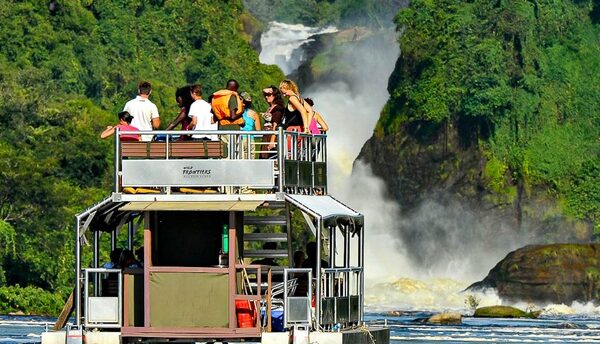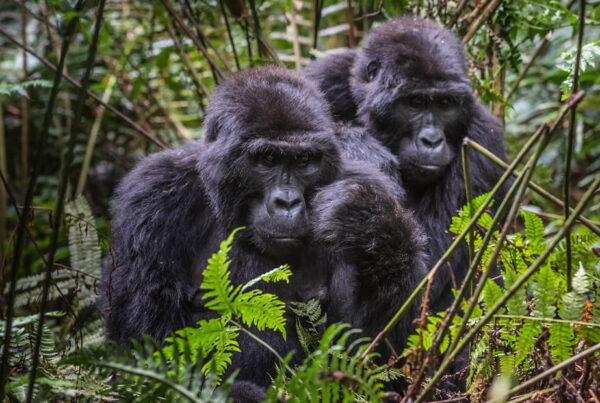Mountain Gorilla: The Majestic Guardian of Africa’s Volcanoes
Witnessing the Giants of the Misty Mountains
High in the mist-laden forests of the Virunga volcanic mountains and the Bwindi Impenetrable Forest, a living legend quietly thrives, embodying both strength and vulnerability. The Mountain Gorilla (Gorilla beringei beringei), one of the most iconic and endangered primates on the planet, captivates all who are fortunate enough to observe it in its natural habitat. Revered for its imposing physical presence, intricate social structure, and profound intelligence, this subspecies represents the delicate balance of Africa’s highland ecosystems.
Despite its powerful stature and adaptability, the Mountain Gorilla has been critically threatened by human encroachment, habitat destruction, poaching, and disease. Conservation efforts over the last several decades have become a model for wildlife protection, demonstrating how careful management and community involvement can sustain populations in the wild. Understanding the Mountain Gorilla in depth reveals insights into behavior, ecology, and the broader implications of biodiversity preservation.
Taxonomy and Subspecies
The Mountain Gorilla is a subspecies of the Eastern Gorilla (Gorilla beringei), distinct from the Western Gorilla (Gorilla gorilla). Within the Eastern Gorilla species, two subspecies are recognized: the Mountain Gorilla and the Eastern Lowland Gorilla (Gorilla beringei graueri).
Mountain Gorillas are primarily distributed in high-altitude forests along the borders of Rwanda, Uganda, and the Democratic Republic of Congo. Genetic studies have confirmed their close relationship with the Eastern Lowland Gorilla, yet significant differences in habitat adaptation, body morphology, and social behavior distinguish this subspecies. These distinctions are reflected in their dense fur, smaller but powerful builds, and behavioral adaptations to high-altitude, cooler climates.
Physical Characteristics
The Mountain Gorilla is notable for its robust physique and dense fur, adaptations that allow survival in cold, montane environments. Adult males, known as silverbacks due to the characteristic silvery hair along their backs, can weigh between 160 and 220 kilograms and stand approximately 1.7 to 1.85 meters tall when upright. Females are smaller, averaging 90 to 100 kilograms, yet display remarkable strength and endurance.
Facial features are expressive, with deep-set eyes, broad noses, and prominent brow ridges. Dense black fur covers most of the body, with additional hair protecting extremities from cold temperatures and heavy rainfall. Limbs are muscular and long, enabling knuckle-walking, climbing, and occasional bipedal posturing. Hands and feet are dexterous, supporting manipulation of vegetation, nest-building, and social interaction. The overall physical structure of the Mountain Gorilla reflects both dominance and environmental adaptation, allowing it to thrive in challenging, high-altitude terrains.
Habitat and Geographic Distribution
Mountain Gorillas are confined to high-altitude tropical forests, generally ranging from 2,200 to 4,300 meters above sea level. Their distribution is concentrated in the Virunga Massif, spanning Rwanda, Uganda, and the Democratic Republic of Congo, and in the Bwindi Impenetrable Forest in Uganda. These forests are characterized by thick vegetation, bamboo groves, high rainfall, and frequent mists, creating an environment rich in food resources and natural shelter.
The montane forests provide a variety of plant species, including shrubs, herbs, bamboo shoots, and fruiting trees. Seasonal changes in temperature, rainfall, and food availability influence gorilla foraging patterns and troop movements. Habitat fragmentation and human activity, including agriculture and settlements, have historically restricted the range of Mountain Gorillas, making protected areas and national parks essential for their survival. Despite these challenges, this subspecies has shown remarkable resilience and adaptability within these highland ecosystems.
Social Structure and Behavior
Mountain Gorillas exhibit complex social organization, with troops typically led by a dominant silverback. The silverback assumes responsibility for protection, conflict mediation, and leadership, maintaining cohesion within the group. Troops usually consist of several adult females, their offspring, and subordinate males, known as blackbacks, who have not yet attained dominance.
Behavior is highly social and adaptive. Grooming serves multiple purposes, including hygiene, tension reduction, and social bonding. Juvenile play promotes physical development, cognitive growth, and social learning. Communication is achieved through vocalizations, facial expressions, gestures, and chest-beating. Grunts, roars, and hoots signal threats, assert dominance, or express contentment, while non-verbal cues allow subtle coordination within the group. Nest-building, performed nightly, demonstrates intelligence and planning. Mountain Gorillas construct sleeping platforms from leaves and branches, sometimes on the ground and occasionally in trees, reflecting behavioral adaptability and learned social practices.
Diet and Feeding Habits
The Mountain Gorilla is primarily herbivorous, consuming a variety of vegetation including leaves, stems, shoots, bark, and occasionally fruits when available. Bamboo is a critical component of the diet in certain regions, providing both nutrition and seasonal consistency. Foraging behavior involves strategic movement across the forest floor to access food sources, which can extend several kilometers per day depending on seasonal availability.
Feeding behavior contributes significantly to forest ecology. Seed dispersal by Mountain Gorillas facilitates forest regeneration, while selective feeding influences plant composition and distribution. Their interaction with the forest promotes biodiversity, supporting other wildlife and maintaining ecosystem stability. The dietary habits of Mountain Gorillas are closely linked to seasonal and ecological cycles, demonstrating their intricate relationship with the high-altitude forest environment.
Reproduction and Life Cycle
Reproductive behavior in Mountain Gorillas is closely tied to social hierarchy. Females reach sexual maturity between eight and ten years, while males mature later, attaining full silverback status after twelve years. The dominant silverback typically monopolizes mating within the group, ensuring reproductive success and troop stability.
Gestation lasts approximately 8.5 months, producing a single infant. Twin births are rare and carry significant survival challenges. Infants rely on maternal care for several years, gradually learning essential skills such as foraging, nest-building, and social interaction. Juveniles acquire behaviors through observation, interaction, and play, preparing them for adult roles within their social units. Lifespan in the wild averages 35 to 40 years, although disease, poaching, and habitat disturbance may reduce longevity.
Communication and Intelligence
The Mountain Gorilla exhibits advanced cognitive abilities, reflected in complex communication, problem-solving, and social awareness. Vocalizations, including grunts, roars, and chest-beating, are used to signal danger, assert dominance, or convey contentment. Facial expressions, gestures, and body postures enhance communication, allowing subtle coordination within troops.
Tool use has been observed occasionally, including manipulation of sticks and vegetation for foraging or nest construction. Memory, learning, and problem-solving skills are well-documented, demonstrating high intelligence and social sophistication. These cognitive abilities highlight both the adaptability of Mountain Gorillas and the ethical responsibility of humans to protect and study them in their natural habitat.
Conservation Status and Threats
The Mountain Gorilla is classified as Endangered by the International Union for Conservation of Nature (IUCN), though populations have shown a gradual increase due to intensive conservation measures. Threats include habitat destruction, human encroachment, poaching, and disease transmission. Human-induced environmental changes have historically restricted their range and fragmented populations, making protection within national parks essential.
Poaching, although reduced through stringent law enforcement, remains a threat, often driven by bushmeat hunting and the illegal wildlife trade. Human diseases, particularly respiratory infections, pose additional risks, especially given the genetic similarity between humans and gorillas. Conservation strategies focus on habitat protection, anti-poaching patrols, veterinary interventions, and community engagement to ensure sustainable coexistence. Ecotourism has emerged as a pivotal tool, providing both funding and public awareness while promoting responsible human-gorilla interaction.
Ecological Importance
Mountain Gorillas play a critical ecological role as keystone species in montane forest ecosystems. Their feeding and ranging behaviors influence plant composition, seed dispersal, and forest regeneration. By interacting with vegetation and creating microhabitats, they support numerous other species, including insects, birds, and small mammals.
The health of Mountain Gorilla populations serves as an indicator of forest ecosystem integrity. Their decline would disrupt ecological balance, highlighting the interdependence between wildlife, habitat, and human activity. Protecting Mountain Gorillas ensures the preservation of biodiversity, ecosystem services, and the resilience of high-altitude forests.
Human Interaction and Cultural Significance
Local communities have maintained complex relationships with Mountain Gorillas, ranging from cultural reverence to conflict over land and resources. In some regions, gorillas are regarded as sacred, embodying strength, wisdom, and resilience. Traditional ecological knowledge has informed conservation efforts, offering insights into behavior, habitat use, and ecological needs.
Tourism has transformed human-gorilla interactions, with gorilla trekking becoming a cornerstone of sustainable wildlife tourism. Guided experiences allow visitors to observe gorillas in their natural habitat while generating economic benefits and funding conservation initiatives. Strict protocols are followed to minimize stress, prevent disease transmission, and ensure ethical engagement with wildlife.
The Future of the Mountain Gorilla
The future of the Mountain Gorilla relies on continued conservation action, international cooperation, and sustained public awareness. Strategies include habitat preservation, anti-poaching enforcement, veterinary care, and community involvement. Scientific research remains essential for monitoring populations, understanding behavior, and implementing effective conservation interventions.
Global support is critical, as Mountain Gorillas are emblematic of highland biodiversity and forest ecosystem health. Their protection safeguards both species and habitat, contributing to broader conservation goals and inspiring future generations to value and protect Africa’s natural heritage.
Experiencing Mountain Gorillas in the Wild
Observing Mountain Gorillas in their natural habitat is an unparalleled experience. Guided treks through Volcanoes National Park in Rwanda, Bwindi Impenetrable Forest in Uganda, or the Virunga National Park in the Democratic Republic of Congo allow visitors to witness social interactions, feeding behavior, and ecological roles. The presence of a silverback leading his troop, juveniles engaging in play, and the subtle social dynamics of families leaves a profound and lasting impression.
Responsible tourism protocols ensure minimal impact on gorilla health and behavior while fostering education and conservation awareness. Visitors gain a deep appreciation for the intelligence, social complexity, and majesty of Mountain Gorillas, while directly supporting conservation efforts and local communities.
Conclusion
The Mountain Gorilla is a symbol of strength, intelligence, and ecological significance in Africa’s montane forests. Its survival is intricately linked to habitat protection, responsible human interaction, and sustained conservation initiatives. These majestic primates not only embody the beauty of Africa’s wildlife but also serve as indicators of ecosystem health and biodiversity.
For travelers seeking an unforgettable wildlife experience, guided tours and safaris offer the opportunity to witness Mountain Gorillas in their natural environment. By booking with reputable providers such as WildHorn Africa, visitors can experience these extraordinary creatures while contributing directly to conservation, ensuring that the legacy of the Mountain Gorilla endures for generations to come.





 WildHorn Africa – Authentic and unforgettable tours across Africa, guided by local experts who know the land, wildlife, and culture best.
WildHorn Africa – Authentic and unforgettable tours across Africa, guided by local experts who know the land, wildlife, and culture best.


